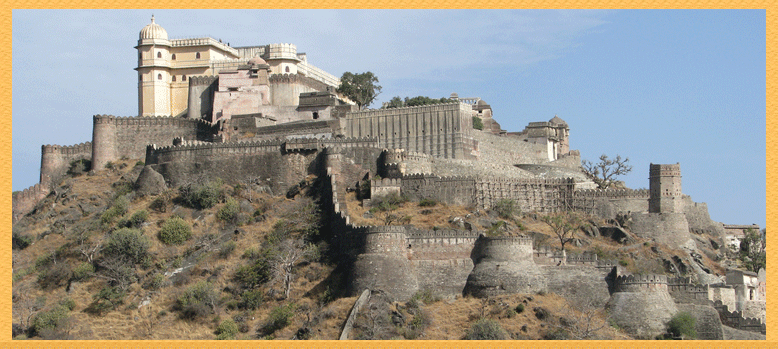Imagine a dark night when the infant Udai Singh is being smuggled from Bundi and hidden in the inner chambers of the Kumbhalgarh fort by his faithful maid Panna Dhai. The reason: to save him from the murderous uncle who desired his throne. The Kumbhalgarh Fort has borne witness to intrigue in its most intense form.
Cradled in a cluster of thirteen mountain peaks of the Aravali range stands this formidable medieval citadel. Rising 1914 meters high from the sea level, the fort was built in the 15th century A.D. by Maharana Kumbha (1419-63 A.D.) and is the principal fortification after Chittaurgarh, 90 kms northwest of Udaipur.
The massive fort is encompassed by a 36 km long wall, has seven majestic gates and seven ramparts, one within the other. Rounded bastion and soaring watch towers loom over the crenellated walls of the fort making it totally impregnable. The 'Nimboo Pol' was built on the western side of the last gate. It was here that the infant Udai Singh was hidden.
Udai Singh ascended the throne of Mewar with Kumbhalgarh as his residence. Later he established Udaipur, a beautiful lake city of the many magnificent palaces and temples within the fort. The most remarkable is the 'Badal Mahal' or the palace of the cloud. At a higher level than all the other royal residences, it offers a breathtaking bird's eye view of the countryside surrounding the fort as well as of the other ruins within.
The ancient ruins of the temples inside the fort date back to the reign of the grandson of the Mauryan Emperor Ashoka who belonged to the Jain community. Understandably most of the ruins in Kumbhalgarh are of Jain temples of various periods.
In the east is a Kali temple and the Mamdev Kund with royal 'Chhatris'. Another temple enshrines a black marble lingam. The mandap or hall of the temple is supported by fine fluted pillars with unique tapering shapes.
Places of interest:-
Haldighati: The scene of the famous battle of 1576 A.D. fought between Rana Pratap - the heroic son of Udai Singh and the massive forces of the Mughal Emperor Akbar. A beautiful chhatri with white marble columns, dedicated to Rana Pratap stands here. Haldighati Museum with light and sound show depicting historical events of Haldighati is worth visiting.
Kumbhalgarh Wildlife Sanctuary: The 586 sq. km sanctuary supporting a rich variety of wildlife like the panther, sloth bear, wild boar, four horned antelope and scientifically breed crocodiles in the lake, are the major attractions. The Sanctuary is also noted for flamingoes, cormorants, spoonbills and egrets usually seen in winter.
Ranakpur Temples: Ranakpur temples (85 km from Udaipur and 50 km from Kumbhalgarh).These beautiful Jain temples are a fine example of the temple architecture. Kankroli- Rajsamand are known for their scenic beauty.
Rajsamand Lake: On the way to Kumbhalgarh lies a magnificent dam- the Rajsamand Lake. The royal lake, built in 1660 by Rana Raj Singh. From here one can have a spectacular view of the sunset with beautiful 'torans' or arches and chhatris adorning the embankment. The lake has a Rest House of the Irrigation Department on the embankment below. The Rest House has a beautifully laid out garden interspersed with exquisite sculptures excavated from the ruins nearby. The town of Kankroli nearby with a marvellous temple and a pretty palace on the hill top offers a scenic experience.
TRAVEL INFORMATION
HOW TO REACH KUMBHALGARH
Air: Udaipur 105 kms is the convenient airport.
Road: Kumbhalgarh Fort is approachable by a good road. No train connection.
GENERAL INFORMATION
Climate: Mean Max. Mean Min.
Summer: 38.3°C 25.8°C
Winter: 28.3 °C 11.6 °C
Rainfall: 61 cms.
Best Season: September-March
Clothing: Summer: Light Tropical
Winter: Light Woollen
Languages: English, Hindi, Mewari
Cradled in a cluster of thirteen mountain peaks of the Aravali range stands this formidable medieval citadel. Rising 1914 meters high from the sea level, the fort was built in the 15th century A.D. by Maharana Kumbha (1419-63 A.D.) and is the principal fortification after Chittaurgarh, 90 kms northwest of Udaipur.
The massive fort is encompassed by a 36 km long wall, has seven majestic gates and seven ramparts, one within the other. Rounded bastion and soaring watch towers loom over the crenellated walls of the fort making it totally impregnable. The 'Nimboo Pol' was built on the western side of the last gate. It was here that the infant Udai Singh was hidden.
Udai Singh ascended the throne of Mewar with Kumbhalgarh as his residence. Later he established Udaipur, a beautiful lake city of the many magnificent palaces and temples within the fort. The most remarkable is the 'Badal Mahal' or the palace of the cloud. At a higher level than all the other royal residences, it offers a breathtaking bird's eye view of the countryside surrounding the fort as well as of the other ruins within.
The ancient ruins of the temples inside the fort date back to the reign of the grandson of the Mauryan Emperor Ashoka who belonged to the Jain community. Understandably most of the ruins in Kumbhalgarh are of Jain temples of various periods.
In the east is a Kali temple and the Mamdev Kund with royal 'Chhatris'. Another temple enshrines a black marble lingam. The mandap or hall of the temple is supported by fine fluted pillars with unique tapering shapes.
Places of interest:-
Haldighati: The scene of the famous battle of 1576 A.D. fought between Rana Pratap - the heroic son of Udai Singh and the massive forces of the Mughal Emperor Akbar. A beautiful chhatri with white marble columns, dedicated to Rana Pratap stands here. Haldighati Museum with light and sound show depicting historical events of Haldighati is worth visiting.
Kumbhalgarh Wildlife Sanctuary: The 586 sq. km sanctuary supporting a rich variety of wildlife like the panther, sloth bear, wild boar, four horned antelope and scientifically breed crocodiles in the lake, are the major attractions. The Sanctuary is also noted for flamingoes, cormorants, spoonbills and egrets usually seen in winter.
Ranakpur Temples: Ranakpur temples (85 km from Udaipur and 50 km from Kumbhalgarh).These beautiful Jain temples are a fine example of the temple architecture. Kankroli- Rajsamand are known for their scenic beauty.
Rajsamand Lake: On the way to Kumbhalgarh lies a magnificent dam- the Rajsamand Lake. The royal lake, built in 1660 by Rana Raj Singh. From here one can have a spectacular view of the sunset with beautiful 'torans' or arches and chhatris adorning the embankment. The lake has a Rest House of the Irrigation Department on the embankment below. The Rest House has a beautifully laid out garden interspersed with exquisite sculptures excavated from the ruins nearby. The town of Kankroli nearby with a marvellous temple and a pretty palace on the hill top offers a scenic experience.
TRAVEL INFORMATION
HOW TO REACH KUMBHALGARH
Air: Udaipur 105 kms is the convenient airport.
Road: Kumbhalgarh Fort is approachable by a good road. No train connection.
GENERAL INFORMATION
Climate: Mean Max. Mean Min.
Summer: 38.3°C 25.8°C
Winter: 28.3 °C 11.6 °C
Rainfall: 61 cms.
Best Season: September-March
Clothing: Summer: Light Tropical
Winter: Light Woollen
Languages: English, Hindi, Mewari



